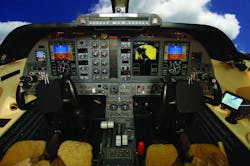Situational awareness is a frequent buzzword in the world of aviation. From a maintenance perspective it deals with self-preservation. Knowing what is going on around us is a great way to avoid incidents or worse yet, accidents involving bodily injury.
In the flight environment there is an equally broad need for awareness. Not only do flight crews need to know what goes on with the aircraft but they require information about weather, potential traffic conflicts, and surrounding terrain.
Real-world environment
Advancements in flight deck displays and computer graphics have enabled a complete virtual real world environment where pilots have access to information that influences the flight.
Perusing the cockpit of almost any recently certified aircraft is an eye-opening experience. In many cases, with power off, the instrument panel appears sparsely populated with perhaps four or five displays along with a few strategically located indicators and switch modules. Once energized it soon becomes apparent that significantly more information can be observed than in years past. In addition, computer animation makes it possible to blend data enabling one image to present many facets.
Even the traditional fault warning panel becomes an integral part of the display system. Once an anomaly is recognized, system software makes a determination if the malfunction should be presented to the flight crew or stored until the aircraft is either on the ground or in a less critical flight envelope. Once a crew advisory is generated, the pilot will often have the ability to select a pertinent display menu allowing synoptic viewing of the system highlighting where the perceived malfunction has occurred.
In addition to providing a more detailed description than a traditional fault panel, this new technology can alter the criticality of the fault relative to the minimum equipment list (MEL) which can provide the crew with immediate guidance about the ability to continue the flight as well as an understanding about further dispatch ability after landing.
Engine indications
In addition to bringing faults to the attention of the crew many systems have the ability to retain this information in some type of central maintenance system (CMS) giving maintenance technicians the ability to review the aircraft’s perspective of a reported malfunction. Even engine indications have become part of the big picture. Digital engine controllers are a natural source of data for electronic displays and may provide additional diagnostic information that can be easily retrieved by technicians.
For years fundamental navigation instruments were installed in a panel using a standard form often referred to as the “Basic T.” Airspeed was in the upper left next to the attitude indicator. The altimeter was on the right and heading belonged just below the attitude. This tried and true standard is still in use today with a few variations and enhancements.
System operating software often has the ability to bias indications based on the aircraft configuration. In some cases airspeed limitations are reduced predicated on aircraft weight or fuel load and operating altitudes may be limited in the event certain automatic flight control systems are not fully operational. The visual cues delivered automatically to the flight crew provide that extra element to ensure safe operation. New display formats are conducive to providing a moving map giving pilots a clear indication of up-to-date aircraft position complete with other air traffic.
Digital weather information
It wasn’t all that long ago that the pilot’s briefing was the main source for obtaining a trip weather report. Onboard weather radar is still the best way to provide storm avoidance but newer digital weather information can now be viewed real time in flight enabling the crew to anticipate altered flight paths well in advance of storm cell visual contact and this information can be applied to the moving map.
The synthetic vision system (SVS) is a computer-mediated reality system for aircraft using a representational three-dimensional format to provide pilots with a clear visual understanding of the airborne environment.
This technology was developed by NASA and the U.S. Air Force in the late 1970s and 1980s in support of advanced flightdeck concepts.
Additional navigation systems
Synthetic Vision employs databases containing detailed information on terrain, obstacle, geo-political boundaries and relative vertical navigation information. A typical SVS application uses the stored data on board the aircraft in unison with navigation information including GPS and inertial reference systems through a processor which provides position information to an image generator and on to the flight deck display. A highway in the sky (HITS) is then used to depict the projected path of the aircraft in perspective view. Pilots acquire instantaneous understanding of the current as well as the future state of the aircraft with respect to the terrain, towers, buildings, and other environment features.
The first FAA certified application of a synthetic vision system was part of the Gulfstream PlaneView flight deck introduced in 2009. This form of the synthetic vision - primary flight display (SV-PFD) replaces the traditional blue-over-brown artificial horizon with the computer-generated terrain overlay with typical PFD symbols. Since then, many newer glass cockpit systems such as the Garmin G1000 and the Rockwell Collins Pro Line Fusion offer synthetic terrain presentations.
Enhanced vision systems incorporate a unique imaging capability, inspired by the forward-looking infrared (FLIR) technology. An infrared sensor that operates in the shortwave infrared (SWIR) spectrum is designed to depict anything producing heat such as runway lights, animals or even other aircraft. The externally mounted thermal detector sends a video image to the flight deck displays, giving the pilots an accurate look at their surroundings even in low visibility. The fact this type of equipment uses temperature differentials can be very useful in depicting inversions and turbulent air.
Even at night, EVS increases visibility of runway markings, taxiways, adjacent highways, and the surrounding landscape. This feature does drastically reduce the margin for error and for controlled flight into terrain (CFIT) which is considered the No. 1 danger in aviation today.
Laptop new maintenance tool
New technology does provide new opportunities for maintenance technicians. The age where analog information comprised of variable voltage, frequency and phase has been superseded by digital data and discrete signals in and out. Use of a volt, ohm meter (VOM) and test lamp and while both still hold importance are loosing ground to the laptop computer and oscilloscope. Understanding the principles of troubleshooting digital data buses and video systems are now paramount.
The nature of our trade is rapidly changing. In years past the guys “upstairs” in the avionics shop would deal with flight deck indication dilemmas and we were trained on instrument removal procedures. Today the training element, while still necessary, is being superseded by a genuine need for education on new technology.
Thorough understandings of system switching and certification requirements are essential for accurate diagnostics and dispatch decisions. Adaptability of a minimum equipment list (MEL) to a digital flight deck is not without challenge. Often when a fault message is presented an underlying cause may be the culprit. Maintenance diagnostic systems do incorporate different design philosophies where some can sense ON/OFF along with understanding valid logic functions it may not always be intuitive enough to provide accurate diagnosis without applying a significant amount of brain power.
Situational consciousness in aviation maintenance will always be an important part of what we do but with equipment used in the flight decks of today is creating an entirely new awareness.
Jim Sparks has been in aviation for 30 years and is a licensed A&P. He is the manager of aviation maintenance for a private company. He can be reached at [email protected].
About the Author

Jim Sparks
Jim Sparks has been maintaining aircraft for almost 40 years with the majority of the time involving Business Aviation activities. Jim’s endeavors have placed him on six of the seven continents contending with numerous situations from routine flight dispatch to critical AOGs. His career includes maintainer, avionics/electrician, educator, tech rep, and director of aircraft maintenance. In addition to other activities he is engaged with ASTM assisting in the global development of criteria defining the Next Tech for NEXTGEN. You can reach him at [email protected].
